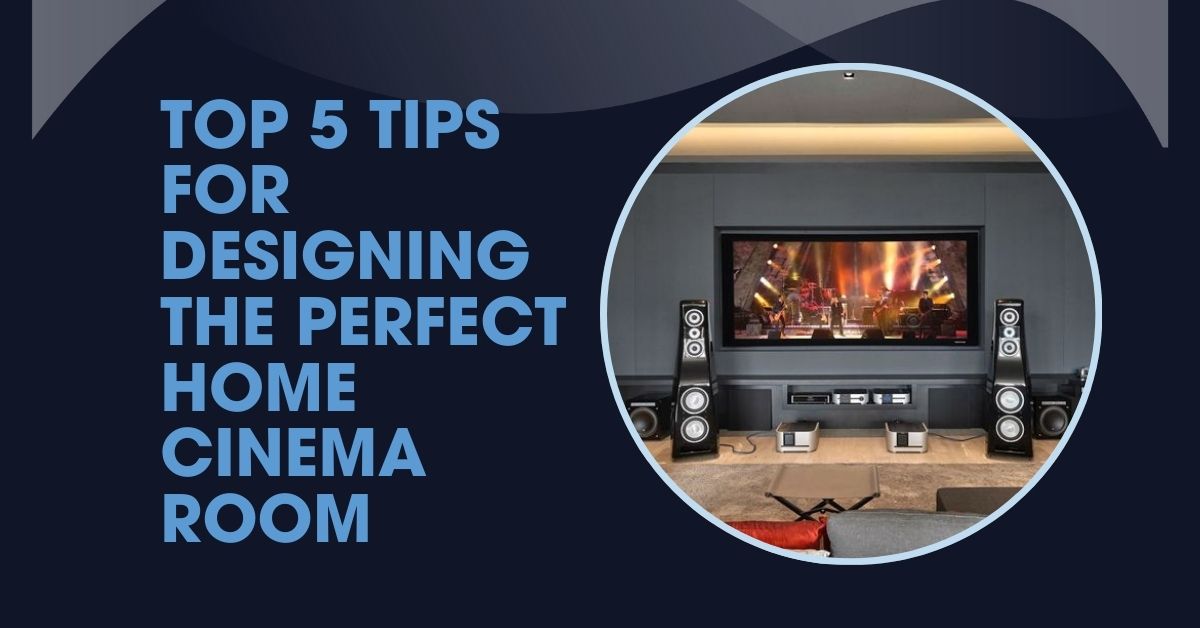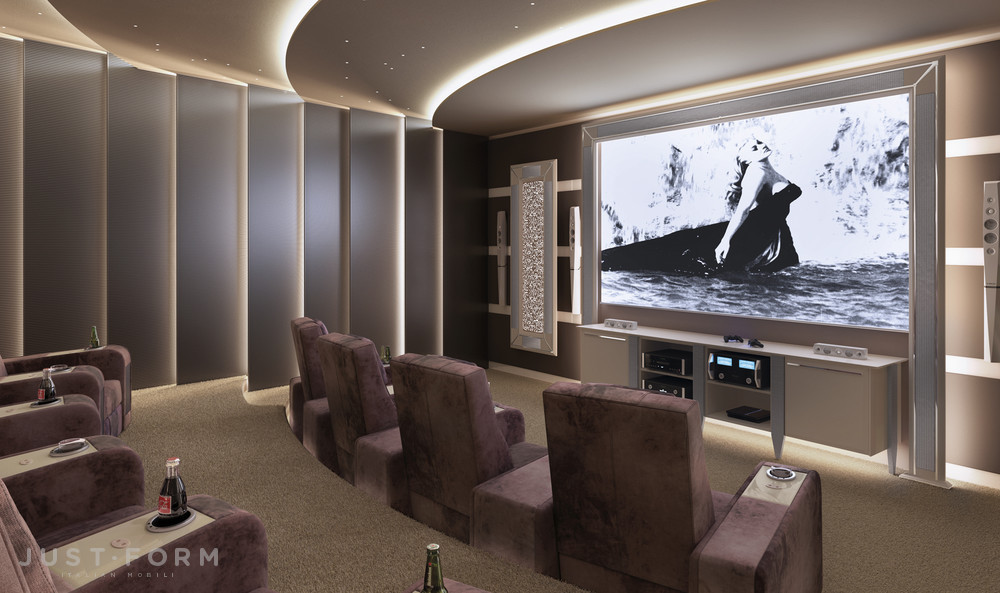
Imagine settling down after a long day, dimming the lights, and immersing yourself in a thrilling movie, all from the comfort of your home. With the right design, your living space can transform into a private cinema, offering you the ultimate movie-watching experience. However, designing the perfect home cinema room requires more than just setting up a TV and a comfy couch. There are a variety of factors to consider to create the ideal environment for watching films.
In this blog, we’ll cover the top 5 tips for designing your home cinema room. Whether you’re building from scratch or upgrading an existing space, these tips will help you create a comfortable and high-quality home theater that will impress your family and friends.
1. Choose the Right Room
The first step in designing a home cinema room is selecting the perfect space. Not all rooms are suited for a cinematic experience, so take time to choose wisely. Ideally, you want a room that is quiet, isolated from outside distractions, and has enough space to fit your equipment and seating comfortably.
Note – Looking to create the perfect Home Cinema in Dubai? Grandkolours offers expert solutions to help you design and install a state-of-the-art home theater that fits your space and budget. From selecting the best equipment to optimizing sound and lighting, their team ensures a seamless, immersive movie experience. Contact Grandkolours today to bring your home cinema vision to life!
What to Look for in a Room
- Size: A larger room gives you more flexibility in terms of seating arrangement and equipment placement. However, even smaller rooms can be transformed into great home cinemas with the right setup.
- Shape: Rectangular rooms tend to work best for home theaters, as the shape allows for better sound distribution. Avoid rooms with too many corners, as they can cause sound issues.
- Light Control: Ideally, you want a room that can be fully darkened when watching movies. Choose a space with windows that can be covered or blocked to prevent sunlight from interfering with your viewing experience.
- Noise Levels: Choose a room that is relatively quiet and away from household noise. If this isn’t possible, consider adding soundproofing materials to keep unwanted noise from distracting you during movie time.

Considerations for Smaller Spaces
If your home doesn’t have a dedicated room for a cinema, you can still create a great movie-watching experience by using a multi-purpose room, such as a basement, living room, or even a converted attic. Just make sure you can control the lighting and noise levels, and ensure there’s enough room for the seating and equipment.
2. Invest in Quality Audio and Visual Equipment
When designing a home cinema room, your audio and visual equipment should be a top priority. The right combination of screen and sound system will make a huge difference in your movie-watching experience.
Choosing the Right Screen or Projector
- Projector vs. TV: A large projector screen will give you that true cinema experience, especially if you want a big, immersive screen. However, a high-quality 4K TV can also offer sharp, vibrant images, and it’s often easier to set up. Choose the option that works best for your space and viewing preferences.
- Screen Size: A screen that’s too small will make the viewing experience less enjoyable. A good rule of thumb is to have your screen size about 1.5 to 2 times the distance from where you’ll be sitting. For example, if your seating is 10 feet from the screen, aim for a screen that’s at least 60-80 inches.
- Resolution and Technology: If you opt for a projector, make sure it offers at least 1080p resolution for clear and sharp images. 4K projectors and TVs are becoming more affordable and offer incredible image quality, so this is a great investment if you want the best viewing experience.
Audio Equipment
Great sound is just as important as great visuals when it comes to home cinema. A basic TV speaker won’t cut it if you want to experience deep, immersive sound.
- Sound Systems: A surround sound system is essential for creating an immersive experience. Look for systems with multiple speakers, such as 5.1 or 7.1 configurations, to ensure that you get a rich, full sound experience.
- Speakers: Pay attention to the quality and placement of speakers. Consider in-wall or in-ceiling speakers for a clean, professional look. A subwoofer is also important for adding depth to sound, particularly in action or thriller movies.
- Sound Calibration: A professional audio system often comes with the option to calibrate sound for your specific room layout. This ensures that the sound is balanced, clear, and provides an even distribution of sound throughout the space.
3. Focus on Comfortable Seating
Comfortable seating is a crucial aspect of any home cinema room. After all, what good is a high-quality sound and picture setup if you’re uncomfortable during the movie? Consider investing in seating that is not only comfortable but also enhances the overall experience.
Types of Seating
- Recliner Chairs: Recliner chairs are one of the best options for home cinemas. They allow you to relax and find your ideal viewing angle, often with built-in cup holders, armrests, and adjustable footrests.
- Sofa or Sectional: If you have a larger group, a sofa or sectional might be a better fit. Look for sofas with deep cushions and supportive backs to ensure comfort for long movie marathons.
- Theater-Style Seating: For a true cinema experience, you can opt for theater-style seating with rows of recliners or individual seats. These often have built-in features like cup holders, trays, and even heated seats for added luxury.
Layout and Spacing
Arrange your seating in a way that ensures everyone has a good view of the screen. Avoid placing seats too close to the screen, as this can cause eye strain. Ideally, the main seating area should be at least 8-10 feet away from the screen, but this will depend on your room size and screen size. If your space allows, consider tiered seating, which raises each row slightly for better visibility.
Seating Capacity
Consider how many people you expect to have in your home cinema at once. Make sure you have enough seating to accommodate everyone comfortably. It’s also important to leave enough space between seats to avoid overcrowding, especially if you have recliners or large chairs.
4. Lighting and Ambiance
The right lighting is key to creating the perfect home cinema experience. Poor lighting can cause glare on the screen or ruin the overall atmosphere. You’ll want to balance enough light for safety with the mood you want to create for watching movies.
Dim or Adjustable Lighting
The best home cinema rooms have dimmable lighting, which allows you to control the level of light based on the movie you’re watching. Consider adding soft, indirect lighting, such as recessed lighting or wall sconces, which can create a cinematic atmosphere without drawing attention away from the screen.
- LED Strips: Installing LED strips behind the screen or around the room can add a nice glow and create an immersive feel without overpowering the space. These strips can change colors to match the mood or the scene of the movie.
- Smart Lighting: With smart lighting, you can control your lights with a remote or smartphone, easily dimming them for movie time and brightening them during intermissions or when you need to get up.
Avoiding Glare
Make sure the lighting doesn’t create reflections or glare on the screen. For rooms with windows, invest in blackout curtains or blinds to control natural light during the day. This ensures that nothing will interfere with your viewing experience, especially if you’re watching in the daytime.
5. Acoustic Treatment
Good sound quality isn’t just about having the right speakers; it’s also about controlling how sound behaves in the room. Unwanted echoes or sound distortion can ruin your movie experience. That’s where acoustic treatment comes in.
Adding Acoustic Panels
Acoustic panels or foam tiles can help reduce sound reflections and ensure a balanced, clear audio experience. These panels are usually placed on the walls or ceiling and help absorb sound, preventing echoes or reverberations that could distract from the movie.
Carpet and Curtains
Soft materials like carpets and heavy curtains can also improve sound quality by reducing sound bounce. Carpets not only make the room more comfortable, but they also absorb sound, creating a more controlled and balanced acoustic environment.
Avoiding Hard Surfaces
Avoid using too many hard surfaces in the room, like bare wood floors or large glass windows, as they reflect sound. By incorporating softer, sound-absorbing materials into your design, you can create a better audio environment.
Conclusion
Designing the perfect home cinema room involves more than just picking the right TV or projector. By choosing the right room, investing in quality audio-visual equipment, focusing on comfortable seating, setting the right ambiance with lighting, and treating the room for optimal sound, you can create a movie-watching space that feels just like a real theater. With these top 5 tips, you’ll be well on your way to enjoying the ultimate home cinema experience.
For more insightful articles related to this topic, feel free to visit topicterritory.com





Leave a Reply